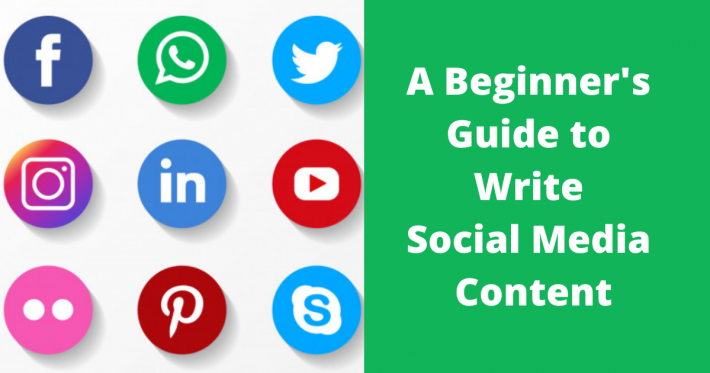Do you wonder why the content of the various social media platforms like Facebook, LinkedIn and Twitter are written in a different way? Do you want to learn how to write social media content? Well, you have certainly landed on the right page.


In recent years social media has become a massively important medium. With millions of active monthly users, an extremely diverse user base, and touching nearly every corner of the planet, it is obvious why the numerous social media sites, ranging from Facebook to LinkedIn, have distinguished themselves as such important and significant places to share content.

The ever-changing algorithms of social networks make it extremely difficult to create interaction with your posts on social media. However, you can make your message more appealing to more individuals by applying some basic writing tips. Taking a content writing course is certainly a building block.
I’m sure you want to get a decent return on your investment if you spend time, effort, and money on posting on social media. The return should see you reach, or surpass, the targets you have established for each platform, but many of your efforts would be wasted if you post without a social media plan that explains how each platform will help you achieve your business goals.
It is necessary for your success to have a social media strategy and action plan based on your specific business objectives, resources, and available time. Yet, you still need to build social media posts and content that appeal to your defined audience, even with a well-designed action plan, and encourage them to take action.
We will share our social media writing tips with you in this article so that you too can improve your writing and hit those all-important Key Performance Metrics.
Top 9 Tips to Write Social Media Content
1. Research is Necessary to Write Social Media Content

You must make them highly important to your target group if you want your audience to notice and interact with your social posts. The more important your posts are, the more success you will have – however, in general, relevance is not adequate. To fully understand your audience, you must take the time. Begin with and then go deeper with the general demographic details.
What criteria, hurdles, or difficulties do they have? Choose a need or problem that right now might be a high priority for them, then create content and social media posts that provide a solution for them.
Share successes from your past, happy clients, in order to communicate with your audience on an emotional level. As a result of using your product or solution, this will help them imagine their own success and make them more optimistic about you.
2. Audience Specific
When you want to write social media content, the audience is important, and there’s no way you’re going to be able to answer them properly if you don’t know who they are. Do what you can to build potential customers, study the audience, and gain a good understanding of who they are and what they care about with this in mind.
This move would also help to ensure that the posts you publish on social media would have a wide, broad reach with the ability to expand far beyond your audience, in addition to helping you to customize your content more effectively.
Take your analysis further and understand what language your potential consumers use to express their desires or difficulties. To ensure your content resonates with your audience, use this language while writing your posts. This will help to explain to them that you do appreciate them and their difficulties.
For example, a post you write for top officials on LinkedIn would read very differently from a post you write for young mothers on Facebook. Not only do these two types of individuals have different issues and points of view, but their vocabulary often varies greatly, the exact phrasing they use to communicate about their needs and challenges.


3. Develop a Distinct Brand Voice
The overall message should be written in your own voice, but you should write social media posts in the language of your target audience. You build your voice with the vocabulary and tone you use when writing your content or communicating with your audience. Your voice (or your brand voice) refers to the personality and passion incorporated into all of your online marketing activities and social interactions.
This voice is mostly influenced by your personality or the personality of your business – your ‘why’ tale and the vocabulary used by your ideal clients. Throughout the content you make and the posts you share on social media, this voice needs to be consistent, as well as any interaction you have on those networks. This consistency can help your audience interact emotionally with you, create faith, and recognize your posts on social media as yours.
Understand that your pages on social media are not intended to be a clone of your website. You will need to soften your tone to make it more relaxed, even though you are a serious corporate brand. Remember that people use most social media to communicate with friends in the first place and why they follow your Facebook page rather than only visiting your website.
4. Insert Multimedia

Where appropriate, use photos, graphics, and videos to tell the story. More engaging is visual material, which can also tell the tale faster and more succinctly than words alone. Actually, in social media posts, a picture or video may also stand alone while still expressing the full message to your audience.
To write social media content, photographs are as important as they are everywhere else. Fill it up with photos after you’ve written it to make the most of your social content. Beautiful stock photos, in-depth screenshots, and even personal images will go a long way towards enhancing your content and making your readers feel more open and welcoming.
Think for a moment about how you consider posts with pictures vs. posts without pictures in your own social media news feeds to understand why this is so important for good social media material. What ones are your clicks more likely to get? “You’re not alone if you answered “posts with photos.
Although people only remember 10 percent of what they read, they remember 65 percent of what they see, and combining your social media material with a relevant image will make it stay in the heads of your readers.
Bear in mind that video will help allow you to communicate on a deeper level with your audience. Individuals react well to video, as it can humanize you and encourage them to get to know you more closely.
To ensure that your message is shared and that you look professional, customize each piece of visual content for the platform on which you are posting it for the best results.
5. Insert a CTA
Consider asking your audience to do what you want them to do next by adding a call to action (CTA) at the end of your material or social posts. Without one, even if they have enjoyed it and gained meaning from it, most people will not take any action after reading your material.
Any time you write about your brand, you need to be mindful of your CTA or Call To Action. Does that mean you need to be actively promoting yourself? Oh, no. But you do want action from your followers, don’t you? Whether it’s reading your message, watching your video, attending a conversation, posting a post, or attending an event. A desirable answer still exists.
CTAs come in various ways and have various functions. For instance, you can inspire your audience to take CTA actions by:
- Ask them to like or share your posts on your social media
- Ask a question in the comments that they can answer.
- Guide them to another content piece
- Take them to a landing page
- Guide them to your homepage
- Get them to get your newsletter subscription
- On other social media sites, ask them to communicate with you
6. Positive Approach
This doesn’t mean that every post has to be happy – there’s a big difference between happy and optimistic. You want to excite and encourage your audience with your content, and that doesn’t always mean happy posts.
You can want to express your opinion or take a stance on something important to you and your brand in some of your posts. But between taking a stance and threatening or criticizing others, there’s a distinction. On social media, a lot of schoolyard-style bullying occurs. Don’t deal with it.
Whatever you do, stop publicly criticizing anyone or any company). Not only is it unprofessional but also risky to attack others – it can attract more negative people to your profile, which can harm any trust or reputation that you have developed with your current followers.
7. Distinct Approach with Different Platforms
Here’s the thing about social media copywriting: Each social media network is created differently to serve various audience needs. This means, on Twitter you should not use the copy you write for LinkedIn and vice versa. In fact, try to identify the most formal and informal you will be on social media when you write those brand guidelines to set some limits.
Note that various social media sites have various rules” for publishing. For instance, a study shows that Facebook posts with 80 or fewer characters hit a target audience of 88 percent more. You can make Facebook the ideal forum for sharing external content such as videos, exclusive deals, and benefits of blogging, with that in mind. Since readers don’t always read beyond the title and summary, make it eye-catching and add a call to action. And note that it is often more convenient to have a short headline.


Twitter is covered by the same law. More than that, there is a 280-character cap, so all the critical information needs to be included in the definition. The highest click-thru-rate is for tweets of about 120-130 characters. Using videos, gifs and quotes is the perfect way to make your tweets catch the attention of the audience.
At the end of an article, hashtags should be added so that they do not conflict with your message to make sure that they are important. Hashtags can allow readers to identify your posts, but among hundreds of similar hashtags, your content will be lost if there are too many. A smart idea is to create a special hashtag that only your business can use. Encourage people, when sharing their experiences with your product or writing articles, to add it too.
People don’t use Instagram for long-reads either so keeping your posts short and engaging is important. Always make sure the first sentences contain all the essential material.
8. Create Content on Trending Topics

Social networking is an excellent place for taping into current affairs and developments around the internet. Social media content has a relatively short lifetime, in addition to the fact that these things would usually do well with readers, so it is a great step to use it to cover current affairs.
Don’t hesitate to look at trendy hashtags, news outlets, and business events to come up with topics for your next batch of content on social media with this in mind.
9. Engagement Inititaing Content
Your brand is trying to tap into an audience that they might not engage across other mediums if you’ve wanted to dive into social media. There’s almost no other location where you can connect on social media with potential customers as you can. Yeah, that’s supposed to make you a little cautious, but it should be exciting as well.
Many businesses prefer to only speak socially about themselves, whether that means professing their purpose, showcasing their goods or staff, or announcing improvements to the organization. Yeah, that’s cool and all but your followers will get pretty bored if you just do that. Or no one can see the value, to begin with, by following your accounts. Bring your brand down to Earth and begin with something basic, such as user-generated content from a giveaway or customer appreciation post for the related product.
Conclusion
The competition for the time and attention of your audience can be fierce. The key to winning is not fighting but setting yourself apart from the crowd by producing and sharing content and social media that your audience would want to consume.
To write social media content, keep your content and social posts optimistic (not to be mistaken with happy), and make sure your audience can absorb them easily. And look at incorporating photos, videos, and CTAs to maximize the efficiency of your content and drive measurable performance.

